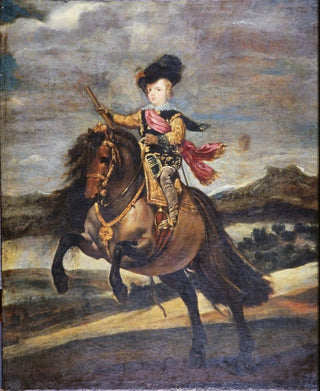Art print | The Infant Baltasar Carlos on horseback - Diego Velázquez


View from behind

Frame (optional)
Art print of the Infant Baltasar Carlos on horseback - Diego Velázquez – Captivating Introduction
In the fascinating world of Baroque painting, the artwork "The Infant Baltasar Carlos on horseback" by Diego Velázquez stands out for its majesty and refinement. Created in the 17th century, this canvas captures the innocence and nobility of a young prince, while revealing the technical mastery of the artist. Immersing ourselves in this iconic scene transports us to an era where art served to glorify royalty and immortalize the prominent figures of history. By contemplating this piece, the viewer is invited to explore not only the beauty of the subject but also the skill with which Velázquez played with light and composition to bring this representation to life.
Style and uniqueness of the work
"The Infant Baltasar Carlos on horseback" is characterized by a unique style that combines realism and idealization. Velázquez, a true virtuoso, manages to render the texture of the clothing and the shine of the young prince's armor with striking precision. The color palette, subtle and harmonious, helps create an atmosphere that is both solemn and intimate. The horse, majestic and powerful, is also a central element of the composition, symbolizing strength and power. The posture of the infant, both confident and gentle, evokes a fascinating duality: that of a precocious child facing the responsibilities that await him. This work, through its perfect balance of elements, demonstrates Velázquez's ability to capture the very essence of his subject while transcending the simple royal portrait.
The artist and his influence
Diego Velázquez, an emblematic figure of Spanish painting, left his mark on his era with a style that combines realism and psychological depth. Trained in Seville, he quickly made a name for himself at the court of Philip IV, where he created numerous works that testify to his creative genius. Velázquez drew inspiration from Renaissance masters while developing a pictorial language that is uniquely his own. His influence is evident in European art, notably among artists like Édouard Manet and Pablo Picasso, who both recognized the impact of his work on their own practice.

Matte finish

View from behind

Frame (optional)
Art print of the Infant Baltasar Carlos on horseback - Diego Velázquez – Captivating Introduction
In the fascinating world of Baroque painting, the artwork "The Infant Baltasar Carlos on horseback" by Diego Velázquez stands out for its majesty and refinement. Created in the 17th century, this canvas captures the innocence and nobility of a young prince, while revealing the technical mastery of the artist. Immersing ourselves in this iconic scene transports us to an era where art served to glorify royalty and immortalize the prominent figures of history. By contemplating this piece, the viewer is invited to explore not only the beauty of the subject but also the skill with which Velázquez played with light and composition to bring this representation to life.
Style and uniqueness of the work
"The Infant Baltasar Carlos on horseback" is characterized by a unique style that combines realism and idealization. Velázquez, a true virtuoso, manages to render the texture of the clothing and the shine of the young prince's armor with striking precision. The color palette, subtle and harmonious, helps create an atmosphere that is both solemn and intimate. The horse, majestic and powerful, is also a central element of the composition, symbolizing strength and power. The posture of the infant, both confident and gentle, evokes a fascinating duality: that of a precocious child facing the responsibilities that await him. This work, through its perfect balance of elements, demonstrates Velázquez's ability to capture the very essence of his subject while transcending the simple royal portrait.
The artist and his influence
Diego Velázquez, an emblematic figure of Spanish painting, left his mark on his era with a style that combines realism and psychological depth. Trained in Seville, he quickly made a name for himself at the court of Philip IV, where he created numerous works that testify to his creative genius. Velázquez drew inspiration from Renaissance masters while developing a pictorial language that is uniquely his own. His influence is evident in European art, notably among artists like Édouard Manet and Pablo Picasso, who both recognized the impact of his work on their own practice.






